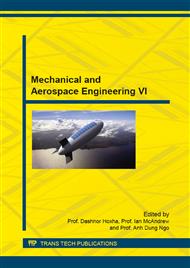p.565
p.571
p.576
p.582
p.589
p.596
p.602
p.609
p.615
Numerical Investigation of Surface Curvature Effects on Aerofoil Aerodynamic Performance
Abstract:
The prescribed surface curvature distribution blade design (CIRCLE) method optimises aerofoils and blades by controlling curvature continuity and slope of curvature distribution along their surfaces. The symmetrical NACA0012 exhibits a surface curvature discontinuity at the leading edge point, and the non-symmetrical E387 exhibits slope-of-curvature discontinuities in the surface. The CIRCLE method is applied to both aerofoils to remove both surface curvature and slope-of-curvature discontinuities. Computational fluid dynamics analyses are used to investigate the curvature effects on aerodynamic performance of the original and modified aerofoils. These results are compared with experimental data obtained from tests on the original aerofoil geometry. The computed aerodynamic advantages of the modified aerofoil are analysed in different operating conditions. The leading edge singularity of NACA0012 is removed and it is shown that the surface curvature discontinuity affects the aerodynamic performance near the stalling angle of attack. The discontinuous slope-of-curvature distribution of E387 influences the size of the laminar separation bubble at lower Reynolds numbers, and it affects the inherent profile of the aerofoil at higher Reynolds numbers. It is concluded that the surface curvature distribution of aerofoils has a significant effect on aerofoil aerodynamic performance, which can be improved by redesigning the surface curvature distribution of the original aerofoil geometry.
Info:
Periodical:
Pages:
589-595
Citation:
Online since:
October 2015
Authors:
Keywords:
Price:
Сopyright:
© 2015 Trans Tech Publications Ltd. All Rights Reserved
Share:
Citation:


